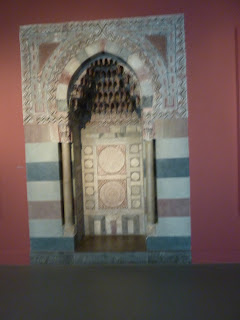The
Pergamon Museum is almost impossible to describe; pictures don’t do it justice. I could have spent the entire day here just listening to the audio and enjoying everything, but in the interest of my dd who doesn’t yet appreciate audio and for whom museums aren’t the most interesting places in the world,
I listened to as much as I could while seeing everything at a reasonable but not leisurely pace.
First was the Pergamon Altar, an altar from Pergamon in Asia Minor built during the 2nd century BC.  The battle on the side apparently shows the battle between the Olympian gods and the giants.
The battle on the side apparently shows the battle between the Olympian gods and the giants.


 The left hand wing was devoted to a new exhibit: the Tell Halaf ruins. Max Oppenheimer brought them back from Turkey around 1900. Originally he had planned to keep them at the Pergamon Museum, but when that didn’t work out, he created his own museum in Berlin. A phosphorus bomb in World War II set the museum on fire—estimated temperature was over 1500 degrees F. Firemen spraying water on them caused them to shatter into more than 27,000 smithereens. The fragments were stored at the Pergamon Museum, but because Max Oppenheimer had moved to the Western part of Germany, nothing could happen for 70 years until the reunification. Now the fragments are being pulled out of storage and are being restored. Most of these pictures are reproductions from teh originals. The one with two objects shows the original as found by Max Oppenheimer and the copy. The large lion-like sculpture
The left hand wing was devoted to a new exhibit: the Tell Halaf ruins. Max Oppenheimer brought them back from Turkey around 1900. Originally he had planned to keep them at the Pergamon Museum, but when that didn’t work out, he created his own museum in Berlin. A phosphorus bomb in World War II set the museum on fire—estimated temperature was over 1500 degrees F. Firemen spraying water on them caused them to shatter into more than 27,000 smithereens. The fragments were stored at the Pergamon Museum, but because Max Oppenheimer had moved to the Western part of Germany, nothing could happen for 70 years until the reunification. Now the fragments are being pulled out of storage and are being restored. Most of these pictures are reproductions from teh originals. The one with two objects shows the original as found by Max Oppenheimer and the copy. The large lion-like sculpture is partially original pieces (2000) and partially additions to make it look like it did before it was bombed.
is partially original pieces (2000) and partially additions to make it look like it did before it was bombed.



After the Tell Halaf exhibit, we walked to the other side to see the Market Gate of Miletus
to see the Market Gate of Miletus ,the Ishtar Gate,
,the Ishtar Gate, 
 countless other things
countless other things
 too numerous to mention, and then upstairs to the Islamic art section including the Mshatta Facade, a gift from Ottoman Sultan Abdul Hamid II to Emperor Wilhelm II of Germany.
too numerous to mention, and then upstairs to the Islamic art section including the Mshatta Facade, a gift from Ottoman Sultan Abdul Hamid II to Emperor Wilhelm II of Germany.


























No comments:
Post a Comment